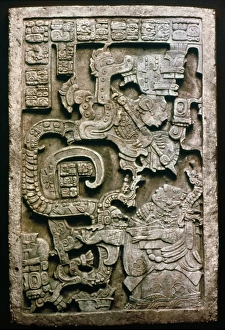Glyph Collection
"Unraveling the Mysteries: Exploring the Fascinating World of Glyphs" Typesetter at work, meticulously arranging ancient symbols that hold stories untold
All Professionally Made to Order for Quick Shipping
"Unraveling the Mysteries: Exploring the Fascinating World of Glyphs" Typesetter at work, meticulously arranging ancient symbols that hold stories untold. Step into Guatemala's Quirigua Archaeological Park, a UNESCO World Heritage Site, and witness the Mayan stelae standing tall, adorned with intricate glyphs. Transport yourself to a time between A. D. 600-800 as you gaze upon a vessel depicting a mesmerizing mythological scene. The creator remains unknown, but their artistry is undeniable. Ah Maxam takes center stage with two remarkable vessels - one showcasing delicate water lilies blooming in vibrant colors during A. D. 750-800 and another revealing dancing lords in all their glory from the same era. Travel back even further to the Late Neolithic period (ca. 3300-2250 BCE) and marvel at an incised glyph bracelet crafted by an anonymous artisan who left behind this enigmatic piece of history. A Mayan polychrome vessel captures your attention next; its surface portrays a cross-legged lord seated on a dais covered with secrets waiting to be deciphered. Intriguingly carved plates emerge from the past, featuring boldly cut-out T-shaped glyphs that leave us pondering their significance. Witness an intense ball game scene frozen in time on a cylindrical vessel from the Late Classic period (c. 682-701). Ceramic craftsmanship brings this captivating moment to life before your eyes. The Palenquean Group of the Cross enchants visitors with its engraved glyphs etched onto stone structures, whispering tales of power and prestige within ancient Maya civilization. Delve into codex Borbonicus through facsimile copies where detailed depictions unfold before you - observe how Oxomoco comes alive through elaborate glyphs intricately illustrated on this sacred manuscript. Finally, get lost in admiration for a shell roundel portraying a cross-legged scribe holding pen in hand, a testament to the importance of writing and communication in Mayan culture.









































